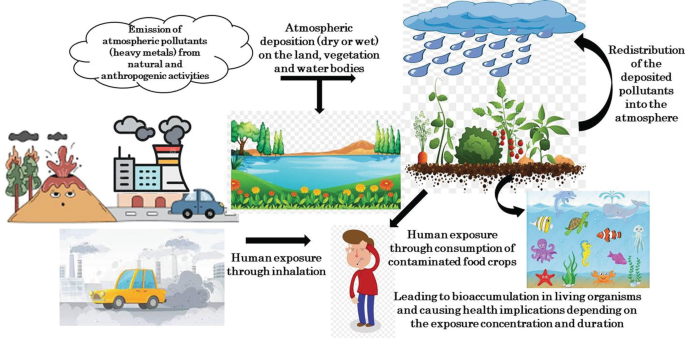CPCB’s 2025 report : Heavy Metals in the Air
India’s air is increasingly contaminated with heavy metals like zinc, copper, and chromium, as revealed by CPCB’s 2025 report. Learn how industrial emissions, vehicular wear, and weak regulations contribute — and what reforms can fix this hidden pollution threat.
CPCB’s 2025 report
A report submitted by the Central Pollution Control Board (CPCB) to the National Green Tribunal (NGT) in 2025 revealed that India lacks defined standards to monitor heavy metals in ambient air quality.
The 2025 CPCB data revealed:
- Delhi’s air contained zinc, copper, chromium, and molybdenum.
- Delhi ranked 5th in zinc, 2nd in copper, and 3rd in chromium and molybdenum among 10 monitored metros.
- Other cities like Ahmedabad and Bhopal showed even higher contamination, pointing to a widespread industrial-origin problem.
How are heavy metals released into the air?
Heavy metals enter the atmosphere primarily as fine or coarse particulates. Major sources include:
- Industrial emissions: Non-ferrous metal smelting, thermal power plants, electroplating, and waste incineration release zinc, copper, lead, and chromium compounds.
- Vehicular exhausts and brake wear: Contribute copper, zinc, and lead particles.
- Construction and mining activities: Resuspend soil and dust particles rich in metals.
- Open waste burning: A significant urban contributor releasing cadmium, chromium, and lead.
- Coal combustion: Adds mercury and arsenic to the air, later deposited on land and water surfaces.
The CPCB’s 2025 study confirmed that these metals are “bound to coarse particulate matter (PM₁₀),” with their percentage fraction ranging between 0.1% and 2.1% of total PM₁₀.
What is the impact of the presence of heavy metals in the air?
Heavy metals are persistent pollutants — non-biodegradable and capable of bioaccumulation.
- Health Impacts: Prolonged inhalation can lead to respiratory ailments, neurological damage, kidney dysfunction, and cancer risks. For instance, chromium (especially hexavalent chromium) is a known carcinogen.
- Ecosystem Impacts: Metals deposit on soil and water bodies, contaminating crops and groundwater, eventually entering the food chain.
- Urban Air Quality Link: CPCB notes that since these metals are attached to particulate matter, reducing PM levels directly lowers heavy metal concentrations.

What are the major challenges in curbing the release of heavy metals in the air?
- Absence of Regulatory Standards: India lacks benchmark values for metals like zinc, copper, molybdenum, and chromium in ambient air. CPCB noted that even agencies such as the US EPA, EU, or WHO have not fixed guideline levels for several of these metals, except specific occupational exposure limits.
- Inadequate Monitoring Infrastructure: Only a few stations measure heavy metals, mostly during short-term studies. Continuous nationwide data is absent.
- Complex Emission Sources: Metals are emitted from diffuse urban sources such as vehicular brake wear, informal recycling, and construction dust, making control measures challenging.
- Data Uncertainty and High Variability: The 2024 study showed wide variation in metal concentrations — complicating risk assessment.
- Weak Enforcement & Inter-Agency Coordination: Coordination gaps between CPCB, state boards, and urban local bodies impede targeted action.
What are the probable solutions?
- Formulation of Ambient Heavy Metal Standards: India can take cues from Ontario’s Ambient Air Quality Criteria (AAQC), which suggests threshold limits such as 120 µg/m³ for zinc, 50 µg/m³ for copper, and 0.5 µg/m³ for chromium. Establishing scientifically validated Indian limits will enable enforcement and accountability.
- Integrated Source Management:
- Adopt stricter norms for industrial stack emissions and waste burning.
- Enforce brake material and tyre composition standards to curb copper and zinc release.
- Promote dust control mechanisms at construction and mining sites.
- Advanced Air Monitoring Networks: Use real-time sensors and chemical speciation analysers for tracking heavy metals within PM₁₀ and PM₂.₅ fractions.
- Public Health Surveillance: Incorporate heavy metal exposure data into National Health and Air Quality programs for long-term epidemiological studies.
- Circular Economy Measures: Encourage safe recycling of electronic and industrial waste to prevent uncontrolled metal release into the environment.
Subscribe to our Youtube Channel for more Valuable Content – TheStudyias
Download the App to Subscribe to our Courses – Thestudyias
The Source’s Authority and Ownership of the Article is Claimed By THE STUDY IAS BY MANIKANT SINGH





